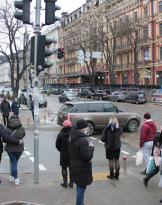You already have an idea at Bamako Senou airport. The yellow fever vaccine is just about done with a syringe that is good for everyone. To get around it, the equivalent of 10 euro in would be enough Sefa, the francs of West Africa.
Bonjour Afrique. Let's start Mali, let's say. Very bad.
Un pick up spotted full of soldiers of the Garde Nationale he passes with more curious than bad faces. The rest is ocher-colored confusion. Bamako is more broken and dirty than other African capitals. Walking around it is like slipping into an earthenware pot: as far as you look around, the view is always the same.
All projects gare routière, buses leave for the North which for the Malians would be the East. It is not a question of squint, just look at a map. The North is the Azawad, the Tuareg prevalence desert area. "It's people from outside, another mentality ..." we would say at the sports bar in Bamako ...
Things are actually more complex. The Azawad is a large box of sand (and some oil) three times the size of Italy. The Arabs and the Tuaregs of the Sahara do not bear the blacks of Bamako since the independence from France of the '60. The matrix of bad mood has always been secular. Ever since radical Islam came to light in West Africa, the fire rekindled with a new flame and flared up in the 2012, with weapons from Libyan origin. With the fall of Gaddafi, in Saharan Africa weapons have turned more than camels ...

France intervened with theArmé de terre andArmée de l'air. The Marine Nationale she stayed at home because Mali has no sea. It has only the large Niger, which is the river, the sea, the cloaca and the highway.
Paris officially intervened in January 2013 with theOpération Serval which, like all official operations, has had a beginning and an end. Today there is theOpération Barkhane which is its continuation on a different basis. In place of the Mirage, Rafale and cavalry armored vehicles ETRANGERE, there are the paràs of the Legion who mostly work at the borders with neighboring countries, Algeria in the lead, to filter out unwelcome arrivals. Preventive surgical operations and more. The French continue to protect their secular interests in Africa ça va sans dire, but it's all very discreet.
So discreet that no one is aware of the recent war until Mopti, on the banks of the Niger. The signs are there but they mix with other problems. Just the carcass of an old BTR remembers that touching the sun-roasted sheets is not a smart gesture.
From Bamako, the road holds for two hours, then from ugly it becomes ugly. Three impressions become certainties:
- Mali does not look like Trentino at all
- there is no limit to human poverty
- the war passes everywhere and blends very well.

It is the Sahel road, the antechamber of the Sahara. Sand, shrubs, sand, bushes, sand, holes, sand, acacias, sand, baobabs, sand. That there is sand in Mali becomes more than a suspect. In reality it is dusty earth that fills everything of the same color.
It takes 12 hours from Bamako to Mopti. 12 African hours. They could be 11 or 20, it is not known.
After Ségou the bus leaves the course of Niger because the area around Markala is infested with armed gangs. Markala was the pivot of the French reconquest in January 2013; the key city to stop the jihad marching towards the capital after the Malian army's route to the North.
After the French arrived the blue helmets of MINUSMA, the UN demagogic mission that between men and police counts 10.000 men. Very personal comes from African neighbors and given the popularity, he controls the situation no better than a drunken blindfold at the wheel.
Those who command from Mopti up, are gangs without a master and above all the Gatia militia, an ally of the government. They are the patriotic of the Tuareg Self-Defense Group who oppose Islamic extremists and declare themselves loyal to Bamako. Like the Arabs of the Arab Azawad Movement, they say they want more autonomy for the North but at the same time the integrity of Mali.
Tuareg and Arab allies of central power? It seems absurd but in reality it is a calculation. The soldiers of Gatia use loose change methods. They settle accounts with Islamic extremism without smelling of colonialism. The same Western chancelleries pretend to be indignant. The anti jihad Tuaregs play at home and are loved by the locals: they are convenient for that too.

With them tagelmust (turbano tuareg), clear camouflage and French weapons, do what the regular army has failed to do and what the French cannot do. In Mali extreme, extreme remedies, one might say ...
In the future they will ask for the bill and the Azawad will have a different weight in the Republic of Mali. Talking about the future in the Sahel, however, leaves the time it finds.
The route continues east to Touna, Bla, Yangasso and San, including nameless mud villages, flies, mosques and Catholic missions.
French becomes rarer and is spoken bambara. The area is known for the calebasse, the pumpkins from which drums and containers are made.
To eat, follow the driver who knows how to do it all over the world. In a hut with benches and pots there is rice and river fish. We have lunch with 2000 CFA, about 3 €. For those without vaccines, typhoid, cholera and hepatitis are included in the price. Diarrhea is also on offer.
At Mopti, made of mud bricks, one stops. To get to Timbuktu and Gao we need the Niger River. From here on, the Islamists had occupied everything. Now no longer. Let's check.
Mali is a warm ocean of dust. Stuffing our noses is a continuous risk with a unique charm.
(teacher)












